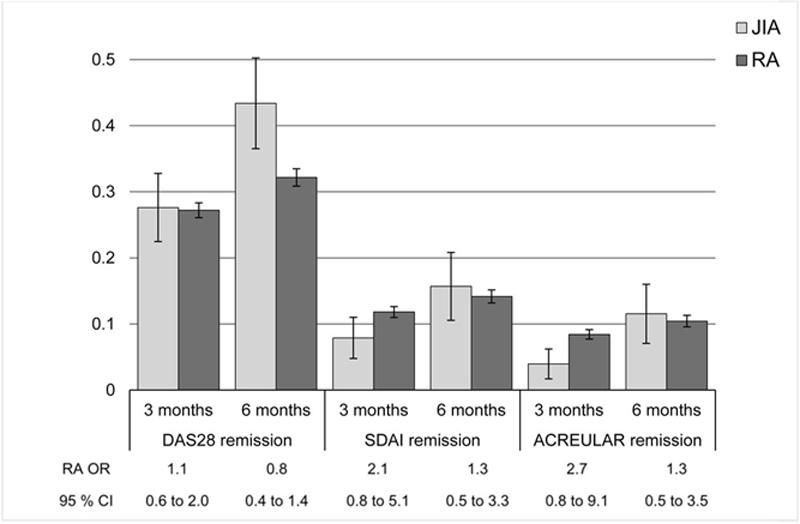

Background: Juvenile idiopathic arthritis (JIA) can cause considerable pain and disability in childhood and adulthood. The number of studies exploring the efficacy of medications in adult JIA patients is limited. Methotrexate (MTX) is a commonly used medication for this patient group.
Objectives: To explore the effects of MTX monotherapy (mono) on disease activity in adult patients diagnosed with JIA, compared to a weighted rheumatoid arthritis (RA) cohort.
Methods: Data from NOR-DMARD, a longitudinal observational study enrolling patients > 18 years starting or switching DMARD treatment for inflammatory joint disease, was used [1]. Patients starting MTX mono treatment, and with a clinical diagnosis of JIA or other inflammatory arthropathies diagnosed before the age of 16 years, were identified from the study population. RA patients starting the same treatment regimen were included for comparative purposes.
Disease activity measurements and remission rates were collected at baseline, 3 and 6 months. Changes in disease activity and absolute remission rates after 3 and 6 months were calculated. Remission rates and change in disease activity from baseline were compared between JIA patients and a weighted RA cohort with weights based on age and gender, using linear and logistic regression for continuous and categorical variables, respectively.
Results: 2201 patients were included in the analyses, 101 JIA patients (80.2% female, mean (SD) age 35.6 (13.0) years, mean (SD) diagnosis duration 24.8 (12.9) years), and 2100 RA patients (69.4% female, mean (SD) age 56.6 (13.6) years, mean (SD) diagnosis duration 4.1 (8.1) years) were included in the analyses. Age, gender distribution and disease duration differed significantly between cohorts.
Both the JIA and RA group improved significantly across all disease activity measures from baseline to 3 and 6 months (
| Baseline | Change to 3 months | Change to 6 months | |||||||
| JIA* | RA* | Diff. § | JIA* | RA* | Diff. § | JIA* | RA* | Diff. § | |
| ESR, mm/h | 20.4 (18.2) | 28.7 (22.2) | 3.7 (-0.6 to 8.1) | -3.1 (15.8) | -9.6 (18.7) | -5.7 (-10.1 to -1.4) | -3.0 (17.5) | -11.3 (19.8) | -5.4 (-10.8 to 0.03) |
| SJC28 | 3.9 (4.8) | 6.9 (5.7) | 2.0 (0.9 to 3.2) | -1.8 (3.3) | -3.5 (5.5) | -0.9 (-1.9 to 0.02) | -1.8 (3.3) | -4.2 (5.6) | -1.5 (-2.6 to -0.5) |
| TJC 28 | 4.5 (4.9) | 8.0 (7.1) | 3.1 (1.9 to 4.2) | -0.8 (4.2) | -3.5 (7.4) | -1.9 (-3.1 to -0.7) | -1.4 (3.8) | -4.0 (6.8) | -2.3 (-3.4 to -1.1) |
| DAS28 | 4.0 (1.3) | 4.9 (1.3) | 0.6 (0.2 to 0.9) | -0.6 (1.2) | -1.2 (1.5) | -0.5 (-0.9 to -0.2) | -0.7 (1.2) | -1.4 (1.5) | -0.6 (-1.0 to -0.2) |
| SDAI | 18.3 (11.3) | 26.0 (13.6) | 5.6 (2.7 to 8.4) | -6.0 (9.7) | -11.0 (14.0) | -3.1 (-5.9 to -0.2) | -6.3 (8.2) | -12.8 (14.2) | -5.1 (-7.8 to -2.2) |
| PGA | 51.0 (24.6) | 48.3 (24.3) | -4.5 (-10.0 to 1.1) | -13.2 (25.3) | -14.7 (26.5) | -1.0 (-7.4 to 5.3) | -11.3 (23.8) | -14.3 (26.7) | -4.6 (-11.9 to 2.7) |
| MHAQ | 0.5 (0.5) | 0.7 (0.5) | 0.1 (-0.05 to 0.2) | -0.2 (0.3) | -0.2 (0.5) | -0.1 (-0.2 to -0.0) | -0.1 (0.3) | -0.2 (0.5) | -0.16 (-0.3 to -0.1) |
*Mean (SD)
§ Weighted group difference, RA coefficient (95 % confidence interval)
Mean 3- and 6-month remission rates with error bars (SE)

Conclusion: Adult JIA patients had significant improvement across all the presented disease activity measures 3 and 6 months after treatment initiation with MTX mono. The magnitude of improvement was smaller than in the RA group, but JIA patients obtained remission at similar rates as RA patients.
REFERENCES:
[1]Kvien, T.K., et al., A Norwegian DMARD register: prescriptions of DMARDs and biological agents to patients with inflammatory rheumatic diseases. Clin Exp Rheumatol, 2005. 23 (5 Suppl 39): p. S188-94.
Disclosure of Interests: Imane Bardan: None declared, Karen Minde Fagerli: None declared, Joe Sexton: None declared, Gunnstein Bakland Speakers bureau: Abbvie, Consultant of: UCB, Pfizer, Novartis, Pawel Mielnik: None declared, Liz Marina Paucar Loli: None declared, Tore K. Kvien Speakers bureau: Amgen, Celltrion, Egis, Evapharma, Ewopharma, Hikma, Oktal, Sandoz and Sanofi, Consultant of: AbbVie, Amgen, Biogen, Celltrion, Eli Lilly, Gilead, Mylan, Novartis, Pfizer, Sandoz and Sanofi, Grant/research support from: AbbVie, Amgen, BMS, MSD, Pfizer and UCB, Eirik kristianslund: None declared, Anna-Birgitte Aga Grant/research support from: Dr. Aga reports personal fees from Abbvie, Eli Lilly, Novartis and Pfizer, outside the submitted work